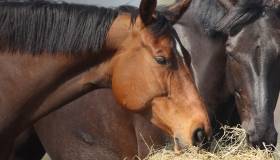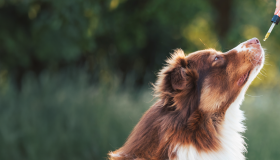
May 12, 2021 – In this episode, Dr. Kelly Diehl talks with Dr. Aarti Kathrani, Senior Lecturer in small animal internal medicine at the Royal Veterinary College about the exciting topic of dietary fiber! The two discuss fiber’s beneficial effects on the gut as well as take a deep dive into the properties of fiber and how these factors determine which type of fiber to use when treating different diseases.
Resources mentioned in the podcast:
- Small Animal Clinical Nutrition, 5th Edition - Hand, Thatcher, Remillard, Roudebush, Novotny
- Applied Veterinary Clinical Nutrition, 1st Edition - Fascetti and Delaney
- Veterinary Clinics of North America Small Animal Practice -
- Volume 51, Issue 3 - Small Animal Nutrition (May 2021)
- Volume 51, Issue 1 - Advances in Gastroenterology (January 2021)
0:00:11.3 Dr. Kelly Diehl: Welcome to Fresh Scoop Episode 32, Everything You Wanted To Know About Fiber But Were Afraid To Ask, and I'm your host, Dr. Kelly Diehl, Morris Animal Foundation, Senior Director of Science and Communication. And today, we're talking to someone from across the pond, as they say. We're talking with Dr. Aarti Kathrani. Dr. Kathrani is a Senior Lecturer in Small Animal Internal Medicine at the Royal Veterinary College. Welcome Aarti, thanks so much.
0:00:40.9 Dr. Aarti Kathrani: Well, thank you so much for having me and for the opportunity to speak to you.
0:00:44.8 DD: And I want everyone to know that I had the great pleasure of listening to Aarti talk about this topic as part of our American College of Veterinary Internal Medicine Online Forum which was quite a leap last year when everyone had to go online, and I just loved it so much that I asked Aarti to come on and talk a bit about what she discussed, which was fiber, and [chuckle] I think there's a lot of discussion of fiber, and people have ideas about fiber because it's just touted so much in human medicine, but I think it's misunderstood and much, much more complex. So can you start with, and I know this is asking a lot, a definition of fiber.
0:01:30.6 DK: Sure, I'll try. So fiber is defined... It's mainly carbohydrates, so most of the different components that make up dietary fiber are carbohydrates, there are some that aren't. But they're present in edible plants, and the hallmark is that they're not hydrolyzed by mammalian digestive enzymes present in the small intestine, nor are they absorbed in the small intestine, so that's kind of the hallmark of these fibers. And so, dietary fibers, they can include celluloses, hemi-celluloses, lignins, pectins, gums, different types, but the characteristics that they all have in common is mainly they're carbohydrates and we're not able to... Mammals aren't able to digest or absorb them in the small intestine.
0:02:21.1 DD: Okay. So that's a good lead into the whole... I think if people hear about fiber, then the next thing they hear about is whether it's soluble or insoluble. [chuckle] So start with that, and then talk a little bit about the other properties of fiber in a big picture that maybe people don't hear about very often.
0:02:43.2 DK: Yeah, so you're absolutely right. The most common classification that people come across is whether it's a soluble fiber or an insoluble fiber, but there are other properties we need to take into consideration. But solubility really refers to the ability of the fiber to be fully dispersed when it's mixed with water. So it's soluble in water, that's really where the definition comes from, and soluble fibers include pectins and gums, so those are examples of soluble fiber, whereas examples of insoluble fiber would be cellulose and lignin. And then, the other properties include viscosity, and so, some fibers have increased viscosity compared to other fibers. And the reason fibers with increased viscosity, the properties, I guess, of those fibers is that because they have increased viscosity, they reduce the rate of passage of digestion through the gastrointestinal tract. And so, what that means is it can slow down the rate of digestion of nutrients and it can help to increase satiety, and that can lead to decreased food intake, so that can be beneficial for your kind of therapeutic weight loss diets.
0:03:52.9 DK: And there's just one more property that we also look at, is the fermentability of the fiber. And so, that's important because there's this common misconception that all soluble fibers are fermentable, and that all insoluble fibers are non-fermentable, but usually, I look at that separately. So I look at these three properties separately. And so, fiber can be described as rapidly to slowly fermentable, and those that are more rapidly fermented, they result in more short-chain fatty acid production in a shorter period of time versus those fibers that are fermented more slowly. And we'll probably talk a little bit more about short-chain fatty acids later, but they're really important because they promote proliferation of the intestinal mucosal epithelium and they contribute to the villus height, and they have so many functions, like mucosal barrier, and preservation, and helping with differentiation of goblet cells and mucus production, and also involved in the immune system in regulating colonic regulatory T cells to prevent excessive inflammation.
0:05:02.4 DD: Okay, so before we move on, because I am going to ask you that, probably, question next [0:05:08.8] ____ variant, is just... And I found this really helpful to think about, is soluble versus insoluble, more viscous and less viscous, and fermentable versus non-fermentable, and then you can put those together because I agree, I think I always thought of ins... Like, big bigger groups versus there's sort of some mixing and matching here. So before we... I just want to make sure I had that straight in my head as we move on. So you alluded to this, but talk a little bit more about what fiber does in the GI tract.
0:05:45.3 DK: Okay, so when we think about the function of fiber, I like to break it down into two main functions or two main pathways just to make it easier to think about. So the first one, the first classification, if you like, is microbiota-independent effects. So those functions would include where fiber can increase the fecal bulk, and that can help, for example, regulate bowel motility, for example, in cases of constipation. And then, we have a microbiota-dependent effects, and that's where the dietary fiber is working through the microbiota. So for example, the fiber may help to support growth of beneficial bacteria like Bifidobacterium and/or Lactobacillus species, and then these bacteria are beneficial and then they'll directly compete with the pathogenic bacteria. And then also in their own right, these beneficial bacteria, they can help to stimulate the intestinal barrier and immune function. And then also, dietary fiber through the microbiota-dependent effects, they're helping to inhibit growth of pathogens and they're decreasing pathogen-induced cytotoxicity, and they can also help to decrease pathogen adhesion because they can have these decoy glucan receptors or these anti-adhesives which helps to prevent pathogens from adhering.
0:07:15.6 DK: And then, the biggest kind of microbiota-dependent effects, which we kind of talked about in the previous... When I answered the previous question, is this short-chain fatty acid production, and that happens through the microbiota. And so, within the microbiota-dependent effects, we have the microbial metabolite production and mainly short-chain fatty acids because those bacteria, they ferment the fermentable fibers and they produce the short-chain fatty acids. And these short-chain fatty acids, they have a lot of really beneficial effects on the colon, so they are important promoters of homeostasis in the colon, they can control colonic motility, blood flow, and intestinal pH, which can have really beneficial effects. The short-chain fatty acids, they're also weak anions, so what they can do is they can draw water and that can exert an osmotic pressure, which can be beneficial in constipation. And depending on how much short-chain fatty acids you produced, when they diffuse through the colonic wall, they can take water with them, which can help with diarrhea.
0:08:22.4 DK: So depending on the amount that's produced, it can help with diarrhea or constipation. And then, one of the important short-chain fatty acids is butyrate, and that's a major fuel source for colonocytes and that can help keep the intestine anaerobic, which is obviously important to prevent pathogens from growing. And then the short-chain fatty acids in themselves can have direct effects on intestinal barrier function and via increase... So they increase mucin production and they decrease tight junction permeability. And there's also a study showing they can be anti-inflammatory and anti-carcinogenic. So there's lots of beneficial effects of dietary fiber in the GI tract, so it can help via the microbiota or even have microbiota-independent effects.
0:09:13.0 DD: We'll talk a little bit more about this, but can you speak very briefly when we think about cats versus dogs and fiber?
0:09:27.4 DK: Yeah, that's a really good point for GI disease, for sure. So I think that there is this misconception about dietary fiber in cats, but although dietary fiber, there's no kind of minimal... There's no really nutrient requirement for it. It does have many beneficial effects, and I think particularly in cats with large intestinal signs. And we've seen quite a few cats that have large intestinal diarrhea-type signs and dietary fiber can really help control their large bowel diarrhea, so it's definitely something worth considering in cats that have large bowel diarrhea, and you're not getting adequate control with a highly digestible, low fiber diet. We would try a high fiber diet in that scenario. And then, the other scenario where fiber can be really beneficial in cats is those cats with constipation or obstipation. So I think we shouldn't be scared to use fiber in cats and there are certain GI diseases where it can be really helpful, for sure.
0:10:30.2 DD: Okay, yeah, that's a good... Thanks for answering that because I think as people think about cats sometimes, they think about cats in the wild and cats in the wild don't... But fiber can be useful for them. So what are the... You've mentioned the pros, a lot of the pros of dietary fiber, are there any cons to dietary fiber, like where can we run into trouble with fiber?
0:10:58.4 DK: So there are some disadvantages with fiber and what fiber can do sometimes, is it can decrease the utilization of nutrients. So it can act as a steric hindrance when... Within the digestive tract when you're trying to get enzymatic hydrolysis. And so, there may be some reduction in bioavailability of nutrients. And in particular, in conditions like exocrine pancreatic insufficiency, if it's hindering the enzymes, then that can obviously be a problem in that condition. And the other thing is, it can bind certain ions, certain fibers can bind certain ions like, or minerals like calcium, zinc and copper, but sometimes that might not be an issue because when the fiber gets fermented in the colon, it can actually release those ions and then there can be absorption that way.
0:11:49.6 DK: I think the other concern is that it can dilute energy and nutrient density. So for example, if you have an animal that doesn't have a great appetite or it's not eating very well, then introducing a food with higher fiber, you have to feed more of that food in order to meet the energy and nutrient requirements. And so, if they're not already... They're not eating a larger volume, they're going to get less calories and nutrients, so it can potentially dilute the energy and nutrient density of a food. And we spoke before about viscous fibers, slowing down rate of gastric emptying and slowing down digestion, so in that respect, sometimes it can increase satiety and it could reduce food intake in certain animals because it may... And also, it may not be palatable if you're adding a lot of fiber to the food.
0:12:43.0 DK: In people, it can worsen dyspepsia, so especially in an animal that's nauseous or has regurgitation, sometimes I do worry about adding too much fiber and what effect that might have on gastric emptying, and certainly, they've seen that in people. If we add too much fermentable fiber to the food, what can happen is, we can get too much short-chain fatty acid production and when bacteria within the colon are fermenting fiber, they're not just producing short-chain fatty acid, they're producing other gases, and so that can lead to abdominal bloating and cramping, increased flatulence. And because there's a lot of short-chain fatty acids there, and we know that those... They're osmotic reactive, these anions, they can draw water into the colon and that in itself could cause increased defecation and diarrhea. And so for that reason, certain fibers, they do have safe upper limits for dog and cat food, just to make sure we don't exceed that limit, so we're not adding too much and therefore not seeing these adverse effects.
0:13:50.3 DD: That's good knowledge. I think also for folks listening, and we'll... We're going to ask Aarti for some resources at the end because it's pretty complicated using different... Beyond the scope of this for different fibers. I think one of the challenges I had when I was in practice is a thin dog with large bowel diarrhea, you know what I mean? Where maybe you have inflammatory bowel disease or a protein-losing enteropathy, but you're dealing with that and trying to titrate or figure out what diet is best. So I'm going to veer in a slightly different direction for a minute because I think for everyone listening, this is confusing, which is, when you look at a label, a package label, a dog food or cat food label about fiber, and I would often get questions in practice about fiber. I mean, you get your diets into your practice, even a prescription diet sometimes can be somewhat daunting. Can you talk a little bit about fiber, how it's reported on a package label and measured?
0:14:57.7 DK: Yeah, and that's a great question, and I think this confuses a lot of people. So the regulations, the pet food regulations in the USA, there is a requirement that it's the maximum amount of crude fiber that's listed on the pet food labels. So whenever you see a pet food label, it's going to be the crude fiber that's listed and it has to be the maximum amount. And what crude fiber is, is it measures most of the insoluble fibers, but none of the soluble fibers. So when we look at crude fiber, and it's not even measuring all the insoluble fibers, it's just most of them. So crude fiber measures insoluble fibers like cellulose, lignin, and some hemi-celluloses are slowly fermentable, but none of the soluble fibers.
0:15:47.3 DK: So crude fiber, it doesn't accurately depict the total dietary fiber in the food. And in fact, there was one study that showed the crude fiber method only accounted for about 5% to 20% of the total dietary fiber in a food. So what we prefer to use is a measure, something called the total dietary fiber. Now that measures the soluble fibers, as well as the insoluble fibers. There are some low molecular weight fibers such as fructooligosaccharides that aren't measured, but it does capture a lot more of the fibers than crude fiber does. And the really interesting thing about total dietary fiber is it's... The method that we use to determine total dietary fiber, it's able to separate out the soluble and the insoluble fiber fractions. So if you look at the product guides of various therapeutic diets in the USA, if you look at the Purina, Royal Canin, or Hill's product guide for the therapeutic diets, what you'll see is that they do list the total dietary fiber, and they also give you the insoluble and soluble fiber content as well.
0:17:04.5 DK: So what I would say is, if you're using a therapeutic diet, I probably... They're not going to report that information on a pet food label because it's not required, but if you go to the product guide or you try and call the pet food manufacturer and you ask them for the total dietary fiber, if it's a therapeutic diet, you should be able to get it from the product guide, if it's over-the-counter diet, I think that's a little bit more difficult because they're not required to measure it, it's not a requirement, so a lot of companies don't. Although, saying that, I did have one company that offered to measure it for me, to let me know, so sometimes you might get lucky and the pet food company, like over-the-counter company or an over-the-counter diet, they may be willing to do that.
0:17:55.5 DK: With regards to supplements that we use commonly, so like Metamucil and wheat bran and those sorts of... When we're adding additional fiber to commercial diets, usually on those labels, they will state the total dietary fiber. So human foods, you'll notice that they will say what the total dietary fiber is on the packaging. So that can be really beneficial when we're adding those kind of of supplements. Whereas pet foods, the requirement at this time is crude fiber and that may change in the future, hopefully, when there is this requirement for total dietary fiber. I think it would make everyone's life easier, for sure.
0:18:33.5 DD: Yeah, because I think that's a problem that I encountered and probably some of our listeners when people want to use commercial diet, right? And I was always perplexed. So in practice, it usually amounted to me adding some kind of fiber supplement, was easier than trying to figure out sending people to the pet food store and so, I almost had to ignore it because it was so hard for me to understand sometimes with that. But that was a really, really great explanation. Thanks for talking about that, that idea of total dietary fiber versus crude fiber because I think crude fiber is really... It's on everything, right? It's on every package. You kind of see that all the time. So I did want to go because it's such a huge subject, can you... Do you have some resources? You mentioned actually the product guides for the therapeutic diets, but are there other resources for veterinarians out there if they want to learn a little bit more about fiber, particularly in any kind of diet?
0:19:44.2 DK: I think that's a really great question. And I think, firstly, I would probably start by looking at the clinical nutrition textbooks. So for example, The Small Animal Clinical Nutrition textbook which is a very thick textbook, it's written by Hand et al. And that textbook has a really good fiber chapter which talks about fiber, the definition of fiber, all the different types of dietary fiber, the different properties, and it also explains the analytical methods. And I think that's really... If you want more information, I think that really helps to provide insight into the way fiber is measured, and it can also... That chapter also gives you useful information when different... We should consider dietary fiber in different conditions. There's also a chapter in Applied Veterinary Clinical Nutrition textbook, and there's also a chapter in Ettinger, which I think are also really helpful. And they're written in a way that's really useful to kind of small animal clinicians, I think, very user-friendly.
0:20:53.0 DK: The Veterinary Clinics of North America, Small Animal Practice, there have been some nutrition editions, and again, there has been a chapter on fiber in one of those reviews, which I think is very, very informative as well because it goes through different studies that have been done on dietary fiber. We've also recognized, I guess, that there is this... There is this gap in dietary fiber in terms of the literature, so we are currently planning to write a review of dietary fiber, so watch this space. And then we're hoping with the review to answer these sorts of questions, and to really help general practitioners and specialists when they're dealing with these cases to make it easier for them in terms of the benefits of dietary fiber, the function, how we read pet food labels, how we decide with different conditions when to try fiber, and when not to. So I think that review hopefully will help to provide a very useful resource on dietary fiber.
0:22:06.6 DD: Great, and for everyone listening, we can pop these on our website on the Podcast page. We could put some of the resources. So as we wrap up Aarti, what is your kind of take home message for veterinarians and pet owners when it comes to thinking about fiber and fiber as part of the diet for cats and dogs?
0:22:34.4 DK: Yeah, I think if I had to summarize take home messages, I think there's a few that I would like to convey. I think the first one is not to think of dietary fiber as a single entity. And I think when you look at dietary requirements in human nutrition, and it's always taken as if dietary fiber is the single entity, but it's not, it's a range of compounds with varying functions. And I think understanding the different properties of dietary fiber, and the different effects those properties bring about in the gastrointestinal tract, or make sure you choose the right dietary fiber for what you need. The first thing is, it's important to realize it's not a single entity, it's a range of compounds with different properties and functions. And then, like we said before, there's many advantages, but there are some disadvantages, so ensuring that you're aware of those disadvantages will ensure that you use the correct strategy when you're particularly thinking about GI cases.
0:23:36.7 DK: And then, another important take home message is this adequate interpretation of dietary fiber and understanding the differences between crude fiber and total dietary fiber when we're comparing different ingredients or therapeutic diets. And I think having that understanding will help with the fine-tuning of these cases, when we're thinking about using dietary fiber because then you're better able to compare different diets and decide where you want to set your total dietary fiber. I think the other really important thing is that the use of dietary fiber at this time, especially in GI disease, remains trial and error because we need more studies. And so, because dietary therapy is trial and error, we should try and utilize dietary fiber whenever possible in our GI cases, and particularly before antimicrobials are considered in cases of large bowel diarrhea.
0:24:35.0 DK: It still amazes me how many people reach for metronidazole and antimicrobials in their large bowel diarrhea cases and they haven't considered fiber. And so, we can really get a lot of improvement with dietary fiber in our large bowel diarrhea cases, and we should really be considering using that before you even move to things like antimicrobials because that could really make a difference, it could really help the animal. And I know that some people say to me, you know, changing different diets and trying different strategies, that takes such a long time and it's really frustrating, and the owner just wants medication. And what I say to them is, response to diet is usually quicker than we think, it can be one or two weeks, it doesn't... We don't have to do these really lengthy diet trials for six to eight weeks before we see a response. And so, it's important to trial different dietary strategies, explain to owners why we're doing that, and just let them know we're not going to do this for a prolonged period of time because... And some owners are amazed on what... They're so amazed when they see the effect of dietary fiber on their animal's large bowel diarrhea, and they're so happy, and we haven't had to use any medication. So I think it's really important to consider it.
0:25:55.6 DD: And I'm going to put it in a plug here as a GI person and a person who was in practice for a long time, I echo your sentiments. We used to have these... We would put a bag together, a little paper bag with a couple of different types of higher fiber prescription diets, we called them... I worked for animal medical specialists, so we called them the AMS Happy Meals, [chuckle] and we would send them out the door and a week, a week, easy. In fact, sometimes shorter, and I absolutely echo what you've said and I would encourage people out there. I was amazed. It is not one of those things where, "Oh, we're going to do a hypoallergenic diet trial and maybe that's going to take six weeks to see anything." Nope, sometimes even within a few days and remarkable.
0:26:45.7 DD: So I agree with you and I would encourage everyone listening to avoid antimicrobials. We sure moved away from them. I'm old and I've been out of practice for 10 years, and even before that, we really shied away. I used to use quite a bit of metronidazole in my early days of practice, and we moved quickly away from that, and then, we had tylan plus diet, and then we went to straight diet years ago, and it's good for antimicrobial stewardship too. And so, I am going to... I second what Dr. Kathrani said, and that winds us up. We are done with another episode of Fresh Scoop. And once again, thanks to Dr. Aarti Kathrani for joining us. It was a great having you.
0:27:33.4 DK: Thank you so much again for the opportunity, I really enjoyed it.
[chuckle]
0:27:37.0 DD: And for everyone listening, we'll be back with another episode next month that we hope you'll find just as informative, and as we know, the science of animal health is ever-changing, veterinarians need cutting edge research information to give their patients the best possible care, and of course, that's why we're here. You can find us on iTunes, Spotify, Google Podcasts and Stitcher. And if you like today's episode, please, we'd sure appreciate if you could take a moment to rate us, there's a sea of podcasts out there, so if you rate us, that helps others find us. And of course, to learn more about Morris Animal Foundation's work, go to morrisanimalfoundation.org, and there you'll see just how we bridge science and resources to advance the health of animals. And you can also follow us on Facebook, Twitter, and Instagram. I'm Dr. Kelly Diehl, and we'll talk soon.




